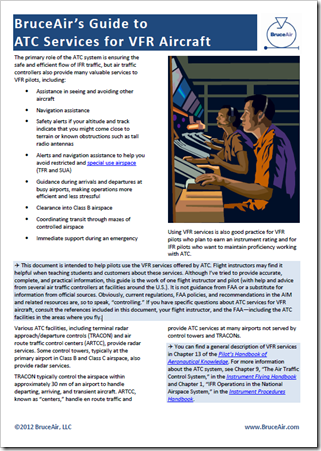 Many pilots seem confused and/or intimidated by “flight following,” the common name for the radar-based services that ATC offers to VFR pilots. Unfortunately, the information about how to take best advantage of these services is scattered among various FAA publications, including the FARs, AIM, ACs, and handbooks.
Many pilots seem confused and/or intimidated by “flight following,” the common name for the radar-based services that ATC offers to VFR pilots. Unfortunately, the information about how to take best advantage of these services is scattered among various FAA publications, including the FARs, AIM, ACs, and handbooks.
To help address this issue, I’ve created BruceAir’s Guide to ATC Services for VFR Pilots (PDF), which you can download from the preceding link.
I worked with several colleagues who are TRACON, tower, and ARTCC controllers to ensure that the basic information is as complete, accurate, and practical as possible. Of course, you may find that things work a little differently in various parts of the country. Individual controllers have their preferences. Workload and local procedures and constraints can affect how things, well, work. But in general, I believe the information in the document is an excellent starting place for pilots who want to use flight following.
As the note at the beginning of this newsletter-style document explains:
This document is intended to help pilots use the VFR services offered by ATC. Flight instructors may find it helpful when teaching students and customers about these services. Although I’ve tried to provide accurate, complete, and practical information, this guide is the work of one flight instructor and pilot (with help and advice from several air traffic controllers at facilities around the U.S.). It is not guidance from FAA or a substitute for information from official sources. Obviously, current regulations, FAA policies, and recommendations in the AIM and related resources are, so to speak, “controlling.” If you have specific questions about ATC services for VFR aircraft, consult the references included in this document, your flight instructor, and the FAA—including the ATC facilities in the areas where you fly.
The document includes an annotated list of and links to references to specific FARs, sections of the AIM, and free resources offered by AOPA Air Safety Institute. I’ve also added a couple of links to books and interactive training products that I recommend to students and customers.
If you’re interested in this topic, download the PDF and review it. Please leave comments here.




